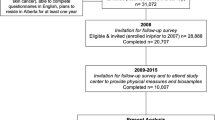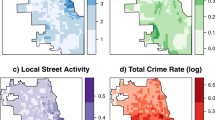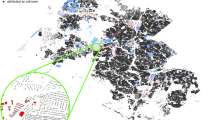Abstract
New methods are needed to efficiently characterize built environment attributes and residential behaviors to improve exposure assessment in epidemiologic research, given limitations of available databases and approaches. Window-opening and presence of air conditioning (AC) units predict indoor air quality and thermal comfort, but data are not widely available. In this study, we tested the utility of a GIS-based tool for rapidly assessing open windows and window/wall AC units in the city of Chelsea, Massachusetts using georeferenced street-level photographs and crowdsourced online surveys. We characterized open windows and window/wall AC units for 969 parcels in the winter and 1213 parcels in the summer, requiring ~40 person hours per season. In the winter, 21% of parcels surveyed had a window or wall AC unit and 19% had an open window. In the summer, 69% had a window or wall AC unit and 53% had an open window. We demonstrated an efficient method for rapidly characterizing open windows and window/wall AC units across an entire city. This tool can help to characterize exposures for epidemiological research, engage community members, and inform local land use planning and decision-making.
This is a preview of subscription content, access via your institution
Access options
Subscribe to this journal
Receive 6 print issues and online access
$259.00 per year
only $43.17 per issue
Buy this article
- Purchase on Springer Link
- Instant access to full article PDF
Prices may be subject to local taxes which are calculated during checkout




Similar content being viewed by others
References
South EC, Hohl BC, Kondo MC, MacDonald JM, Branas CC. Effect of greening vacant land on mental health of community-dwelling adults. JAMA Netw Open. 2018;1:e180298. http://jamanetworkopen.jamanetwork.com/article.aspx?10.1001/jamanetworkopen.2018.0298. Accessed 8 Sept 2018.
Wall MM, Larson NI, Forsyth A, Van Riper DC, Graham DJ, Story MT, et al. Patterns of obesogenic neighborhood features and adolescent weight: a comparison of statistical approaches. Am J Prev Med. 2012;42:e65–75. https://www.sciencedirect.com/science/article/pii/S0749379712001316. Accessed 4 Apr 2018.
Sallis JF, Glanz K. Physical activity and food environments: solutions to the obesity epidemic. Milbank Q. 2009;87:123–54. http://doi.wiley.com/10.1111/j.1468-0009.2009.00550.x. Accessed 4 Apr 2018.
Emenius G, Svartengren M, Korsgaard J, Nordvall L, Pershagen G, Wickman M. Building characteristics, indoor air quality and recurrent wheezing in very young children (BAMSE). Indoor Air. 2004;14:34–42. http://doi.wiley.com/10.1046/j.1600-0668.2003.00207.x. Accessed 7 Sept 2018.
Bailie R, Stevens M, McDonald E, Brewster D, Guthridge S. Exploring cross-sectional associations between common childhood illness, housing and social conditions in remote Australian Aboriginal communities. BMC Public Health. 2010;10147. http://bmcpublichealth.biomedcentral.com/articles/10.1186/1471-2458-10-147. Accessed 7 Sept 2018.
Almanza E, Jerrett M, Dunton G, Seto E, Pentz MA. A study of community design, greenness, and physical activity in children using satellite, GPS and accelerometer data. Health Place. 2012;18:46–54. http://www.sciencedirect.com/science/article/pii/S135382921100164X.
Gascon M, Sánchez-Benavides G, Dadvand P, Martínez D, Gramunt N, Gotsens X, et al. Long-term exposure to residential green and blue spaces and anxiety and depression in adults: a cross-sectional study. Environ Res. 2018;162:231–9. http://linkinghub.elsevier.com/retrieve/pii/S0013935118300124. Accessed 4 Apr 2018.
Taylor BT, Fernando P, Bauman AE, Williamson A, Craig JC, Redman S. Measuring the quality of public open space using google earth. Am J Prev Med. 2011;40:105–12. http://linkinghub.elsevier.com/retrieve/pii/S0749379710006343. Accessed 27 May 2018.
Wilson J, Lindsey G, Liu G. Viewshed characteristics of urban pedestrian trails, Indianapolis, Indiana, USA. J Maps. 2008;4:108–18. http://www.tandfonline.com/action/journalInformation?journalCode=tjom20. Accessed 27 May 2018.
Pikora TJ, Bull FC, Jamrozik K, Knuiman M, Giles-Corti B, Donovan RJ. Developing a reliable audit instrument to measure the physical environment for physical activity. Am J Prev Med. 2002;23:187–94. http://linkinghub.elsevier.com/retrieve/pii/S0749379702004981. Accessed 27 May 2018.
Kelly CM, Schootman M, Baker EA, Barnidge EK, Lemes A. The association of sidewalk walkability and physical disorder with area-level race and poverty. J Epidemiol Community Health. 2007;61:978–83. http://www.ncbi.nlm.nih.gov/pubmed/17933956. Accessed 27 May 2018.
Clifton KJ, Livi Smith AD, Rodriguez D. The development and testing of an audit for the pedestrian environment. Land Urban Plan [Internet]. 2007;80:95–110. https://www.sciencedirect.com/science/article/pii/S0169204606001101. Accessed 27 May 2018.
Johnson T, Long T. Determining the frequency of open windows in residences: a pilot study in Durham, North Carolina during varying temperature conditions. J Expo Anal Environ Epidemiol. 2005;15:329–49. http://www.ncbi.nlm.nih.gov/pubmed/15536488. Accessed 18 Sept 2017.
Bennett GG, McNeill LH, Wolin KY, Duncan DT, Puleo E, Emmons KM. Safe to walk? Neighborhood safety and physical activity among public housing residents. PLoS Med. 2007;4:e306. http://dx.plos.org/10.1371/journal.pmed.0040306. Accessed 27 May 2018
Wilson DK, Kirtland KA, Ainsworth BE, Addy CL. Socioeconomic status and perceptions of access and safety for physical activity. Ann Behav Med. 2004;28:20–8. https://academic.oup.com/abm/article/28/1/20-28/4633673. Accessed 27 May 2018.
Ou JY, Levy JI, Peters JL, Bongiovanni R, Garcia-Soto J, Medina R, et al. A walk in the park: the influence of urban parks and community violence on physical activity in Chelsea, MA. Int J Environ Res Public Health. 2016;13. http://www.ncbi.nlm.nih.gov/pubmed/26742051. Accessed 7 Sept 2018.
Zannin PHT, Calixto A, Diniz FB, Ferreira JAC. A survey of urban noise annoyance in a large Brazilian city: the importance of a subjective analysis in conjunction with an objective analysis. Environ Impact Assess Rev. 2003;23:245–55. https://www.sciencedirect.com/science/article/pii/S0195925502000926. Accessed 27 May 2018.
Pedersen E, Persson Waye K. Perception and annoyance due to wind turbine noise—a dose–response relationship. J Acoust Soc Am. 2004;116:3460–70. https://doi.org/10.1121/1.1815091. Accessed 27 May 2018.
Kotol M. Survey of occupant behaviour, energy use and indoor air quality in Greenlandic dwellings. In: Proceedings of the 5th International Building Physics Conference (IBPC): The Role of Building Physics in Resolving Carbon Reduction Challenge and Promoting Human Health in Building. Kyoto, Japan. 2012. http://orbit.dtu.dk/files/52204200/Article_16_3_2012.pdf. Accessed 27 May 2018.
Andersen RV, Toftum J, Andersen KK, Olesen BW. Survey of occupant behaviour and control of indoor environment in Danish dwellings. Energy Build. 2009;41:11–6. http://www.sciencedirect.com/science/article/pii/S0378778808001655.
Ma L, Dill J. Associations between the objective and perceived built environment and bicycling for transportation. J Transp Heal. 2015;2:248–55. http://www.sciencedirect.com/science/article/pii/S2214140515000110.
Groves RM. Nonresponse rates and nonresponse bias in household surveys. Public Opin Q. 2006;70:646–75. http://academic.oup.com/poq/article/70/5/646/4084443/Nonresponse-Rates-and-Nonresponse-Bias-in. Accessed 27 May 2018.
Brook JR, Setton EM, Seed E, Shooshtari M, Doiron D. The Canadian Urban Environmental Health Research Consortium—a protocol for building a national environmental exposure data platform for integrated analyses of urban form and health. BMC Public Health. 2018;18:114. https://bmcpublichealth.biomedcentral.com/articles/10.1186/s12889-017-5001-5. Accessed 4 Apr 2018.
Middel A, Lukasczyk J, Maciejewski R. Sky view factors from synthetic fisheye photos for thermal comfort routing—a case study in Phoenix, Arizona. Urban Plan. 2017;2:19. http://www.cogitatiopress.com/urbanplanning/article/view/855. Accessed 4 Apr 2018.
Hara K, Sun J, Moore R, Jacobs D, Froehlich JE. Tohme: detecting curb ramps in google street view using crowdsourcing, computer vision, and machine learning. In: Proceedings of the 27th annual ACM symposium on User interface software and technology. Honolulu, Hawaii. 2014, pp 189–204.
Howard-Reed C, Wallace LA, Ott WR. The effect of opening windows on air change rates in two homes. J Air Waste Manag Assoc. 2002;52:147–59. https://doi.org/10.1080/10473289.2002.10470775.
Bekö G, Gustavsen S, Frederiksen M, Bergsøe NC, Kolarik B, Gunnarsen L, et al. Diurnal and seasonal variation in air exchange rates and interzonal airflows measured by active and passive tracer gas in homes. Build Environ. 2016;104:178–87. http://linkinghub.elsevier.com/retrieve/pii/S0360132316301688. Accessed 18 Apr 2017.
MacNeill M, Wallace L, Kearney J, Allen RW, Van Ryswyk K, Judek S, et al. Factors influencing variability in the infiltration of PM2.5 mass and its components. Atmos Environ. 2012;61:518–32. http://linkinghub.elsevier.com/retrieve/pii/S1352231012006772. Accessed 18 Apr 2017.
Rogot E, Sorlie PD, Backlund E. Air-conditioning and mortality in hot weather. Am J Epidemiol. 1992;136:106–16. http://www.ncbi.nlm.nih.gov/pubmed/1415127. Accessed 11 Jul 2018.
O’Neill MS, Zanobetti A, Schwartz J. Disparities by race in heat-related mortality in four US cities: the role of air conditioning prevalence. J Urban Health. 2005;82:191–7. http://www.ncbi.nlm.nih.gov/pubmed/15888640. Accessed 11 Jul 2018.
Semenza JC, Rubin CH, Falter KH, Selanikio JD, Flanders WD, Howe HL. et al. Heat-related deaths during the July 1995 heat wave in Chicago. N Engl J Med. 1996;335:84–90. https://doi.org/10.1056/NEJM199607113350203.
Curriero FC, Heiner KS, Samet JM, Zeger SL, Strug L, Patz JA. Temperature and mortality in 11 cities of the eastern United States. Am J Epidemiol. 2002;155:80–7. http://www.ncbi.nlm.nih.gov/pubmed/11772788. Accessed 11 Jul 2018.
City of Chelsea Massachusetts. About Our City. chelseama.gov. 2018. https://www.chelseama.gov/about-our-city. Accessed 18 May 2018.
U.S. Census Bureau’s American Community Survey Office. B01003: total population, 2012–2016 American Community Survey 5-year estimates. United States Census Bureau/American FactFinder; 2016. https://factfinder.census.gov/faces/tableservices/jsf/pages/productview.xhtml?pid=ACS_16_5YR_B01003&prodType=table. Accessed 20 May 2018.
Massachusetts Executive Office of Energy and Environmental Affairs. Environmental Justice Policy of the Executive Office of Energy and Environmental Affairs. Boston, Massachusetts: Massachusetts Executive Office of Energy and Environmental Affairs; 2017.
Klein RJ, Kinney PL, Metzger KB. Intra-urban vulnerability to heat-related mortality in New York City, 1997–2006. Health Place. 2014;30:45–60. https://www.sciencedirect.com/science/article/pii/S1353829214001087#t0030. Accessed 11 Jul 2018.
Harlan SL, Brazel AJ, Prashad L, Stefanov WL, Larsen L. Neighborhood microclimates and vulnerability to heat stress. Soc Sci Med. 2006;2847–63. https://www.sciencedirect.com/science/article/pii/S027795360600373X. Accessed 11 Jul 2018.
Esri. Overview—Photo Survey|ArcGIS for Local Government. solutions.arcgis.com. 2018. http://solutions.arcgis.com/local-government/help/photo-surveys/get-started/. Accessed 14 May 2018.
City of Chelsea M. Chelsea Property Data. chelseama.gov. 2018. https://www.chelseama.gov/assessor/pages/chelsea-property-data. Accessed 20 May 2018.
Shi S, Zhao B. Occupants’ interactions with windows in 8 residential apartments in Beijing and Nanjing, China. Build Simul. 2016;9:221–31.
Torres Quezada J, Toshiharu I, Coch Roura H, Isalgue Buxeda A. Predominant factors on multi-housing overheating interior conditions and body temperature: a field study in Japan. In: International Conference on Smart, Sustainable and Sensuous Settlements Transformation Proceeding. 2018. p. 163–8. https://upcommons.upc.edu/handle/2117/117071. Accessed 10 Jul 2018.
Kowaltowski DCCK, da Silva VG, Pina SAMG, Labaki LC, Ruschel RC, de Carvalho Moreira D. Quality of life and sustainability issues as seen by the population of low-income housing in the region of Campinas, Brazil. Habitat Int. 2006;30:1100–14. https://www.sciencedirect.com/science/article/pii/S019739750600021X.
Budd T. Burglary: practice messages from the British Crime Survey. London. 2001. http://library.college.police.uk/docs/hoprcbrf/brf501.pdf. Accessed 24 Jul 2018.
Acknowledgements
This work was supported by the National Institute of Environmental Health Sciences (grant number T32 ES014562), the National Institute on Minority Health and Health Disparities (grant number P50 MD010428), and the U.S. Environmental Protection Agency (grant number RD-836156). The funding sources had no involvement in the conduct of this research or preparation of this manuscript. There were no other sources of financial support, sponsorship, or materials. The authors thank GreenRoots, the Chelsea Beautification Committee, and the Chelsea Department of Public Works for their input and ideas related to applications of this data collection method. In addition, we would like to acknowledge Raquel Jimenez Celsi, Daniel Nguyen, Leila Heidari, Felipe Jordán Colzani, Iman Ali, Bailey Alvarado, and Baderha Bujiriri for their important contributions to photograph collection and survey testing. Finally, we wish to thank Chris Buscaglia for his help in setting up the surveys and everyone who completed the surveys online.
Author information
Authors and Affiliations
Corresponding author
Ethics declarations
Conflict of interest
The authors declare that they have no conflict of interest.
Additional information
Publisher’s note Springer Nature remains neutral with regard to jurisdictional claims in published maps and institutional affiliations.
Rights and permissions
About this article
Cite this article
Petropoulos, Z.E., Levy, J.I., Scammell, M.K. et al. Characterizing community-wide housing attributes using georeferenced street-level photography. J Expo Sci Environ Epidemiol 30, 299–308 (2020). https://doi.org/10.1038/s41370-019-0167-9
Received:
Revised:
Accepted:
Published:
Issue Date:
DOI: https://doi.org/10.1038/s41370-019-0167-9



